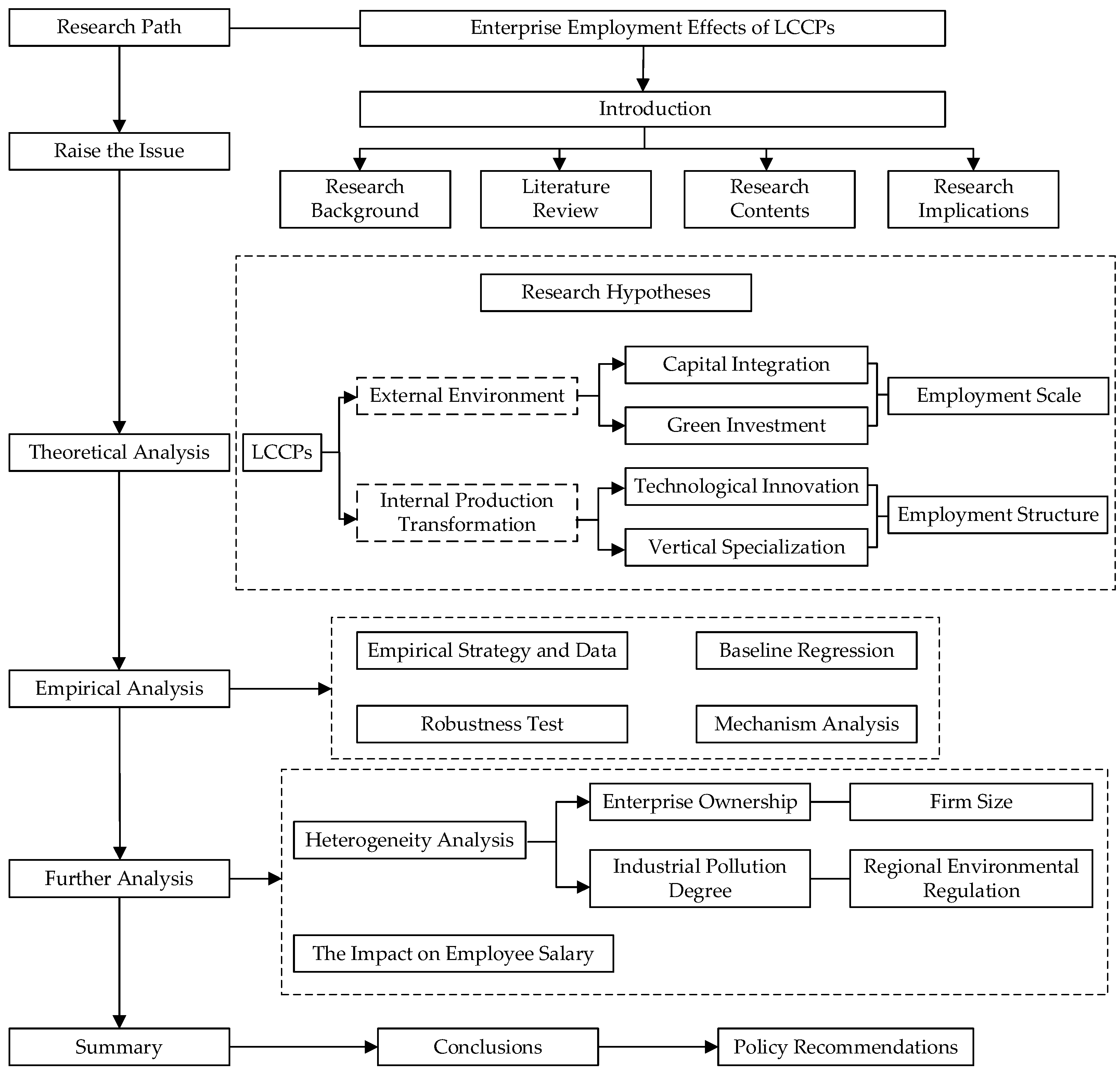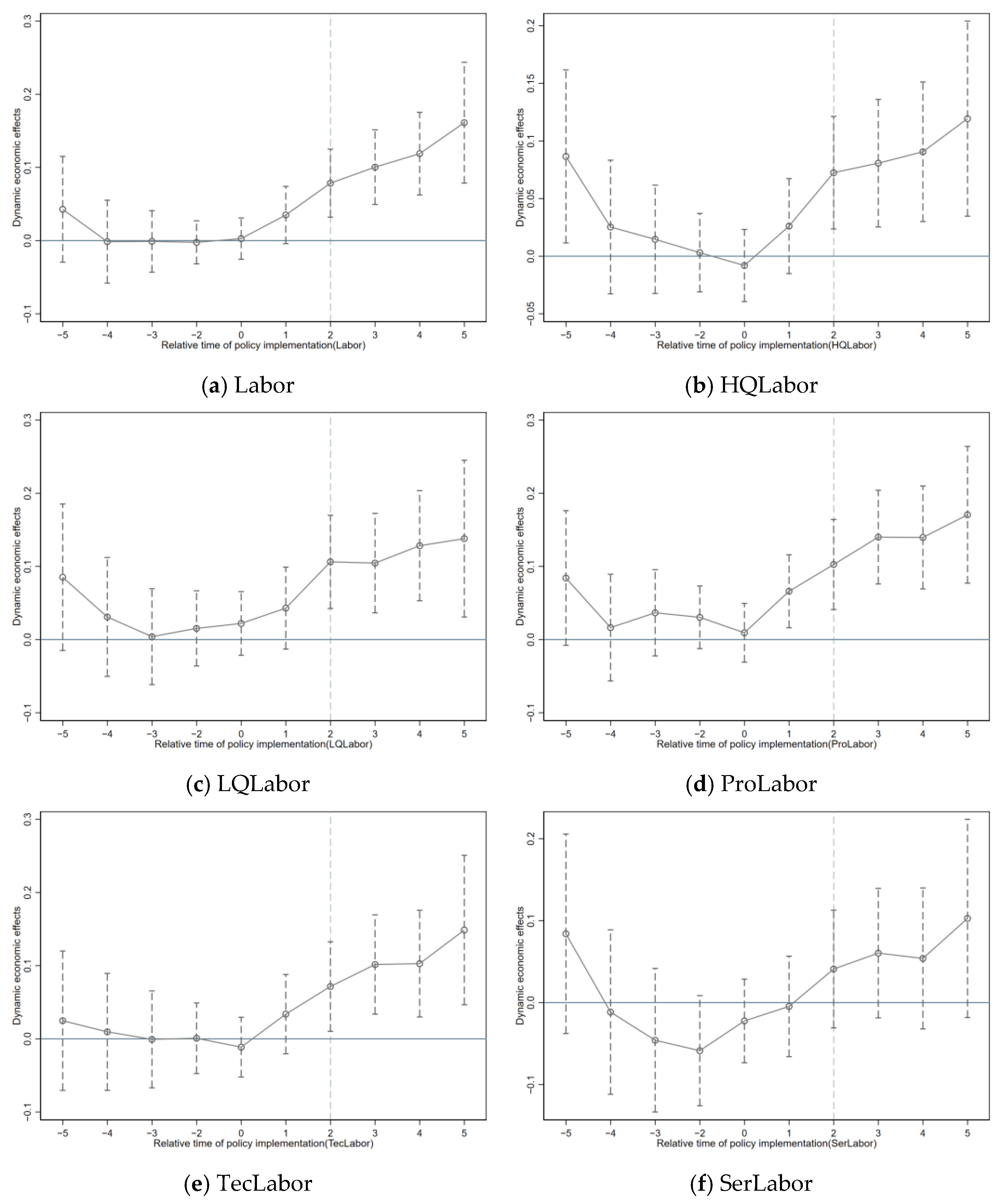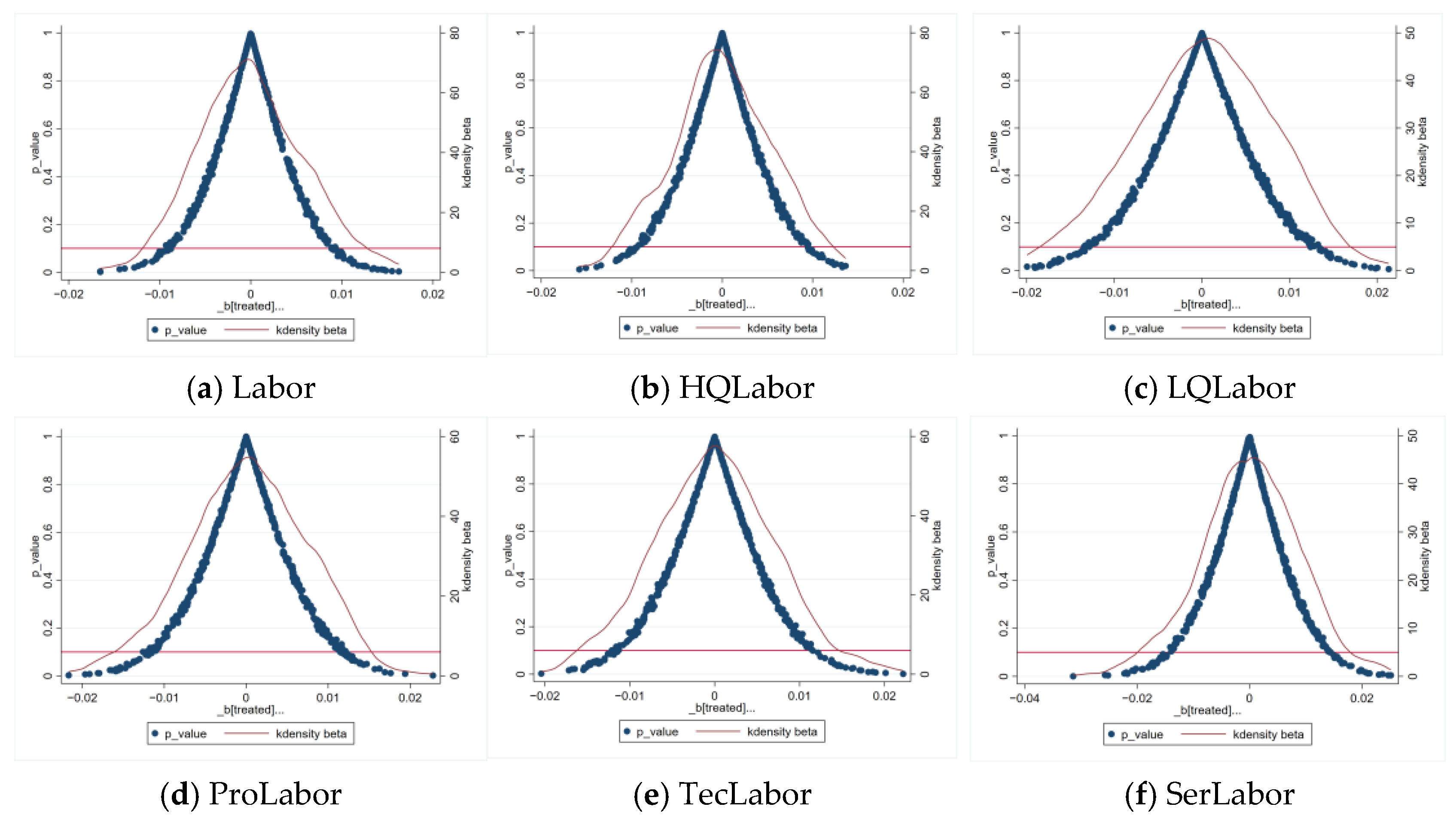1. Introduction
With the increasing severity of global climate change and environmental problems, green and low-carbon transformation has become the only way for countries around the world to move towards sustainable development. At the 75th United Nations General Assembly in 2020, China pledged to reach a peak in carbon dioxide emissions by 2030 and to achieve carbon neutrality by 2060. Low-carbon transformation is not only a strategic choice at the national level but also an important task that every economic subject needs to actively participate in. As the main participants in economic activities, enterprises play a vital role. Low-carbon transformation methods such as clean technology, changes in energy structure, and environmental information publicity in enterprises are the changes made by enterprises at the micro level. These methods have played a key role in reshaping corporate development strategies, promoting production model innovation, and driving economic growth [
1]. To achieve the goal of carbon emission reduction in the short run, the low-carbon transformation behavior of enterprises will inevitably lead to changes in the labor market. Enterprises will change their investment and financing behavior to reallocate factor resources, thus affecting the supply and demand structure of the labor market. The labor force of different industries and enterprises will face competition, elimination, and adjustment of employment [
2]. In the current situation of increasing downward pressure on the economy and reducing demographic dividends, balancing low-carbon development and employment stability is an urgent problem to be solved in China’s current economic and social development.
The low-carbon city pilot policy, launched by China to address climate change and promote sustainable development, began in 2010 with five provinces and eight cities, including Guangdong and Liaoning. The policy expanded with a second batch in 2012 and further deepened in 2017. By 2021, 81 cities across six provinces and regions were included in the pilot program.
Early research on low-carbon city pilot policies focused on emission reduction targets and policy design logic [
3]. Later studies highlighted the environmental and economic benefits of these policies. In terms of environmental benefits, low-carbon city pilot policies can significantly improve air quality and reduce pollutant emissions and carbon emissions [
4,
5]. In terms of economic benefits, low-carbon city pilot policies can promote industrial transformation and upgrading, green technology innovation, and the high-quality development of enterprises [
6]. Institutional theory points out that enterprises usually lack the internal motivation for environmental governance due to the externalities of environmental pollution. However, reasonable environmental regulation will encourage enterprises to increase green investment for the purpose of transforming technological processes and realizing “innovation compensation”. This leads to the internalization of governance costs, which affects the production and performance of enterprises [
7,
8]. Wang et al. [
9] used enterprise-level data to investigate the impact of policies on the green technology innovation of enterprises and found that the pilot policy would promote the green technology innovation of listed companies in pilot cities. The policies mainly induce the overall green technology innovation of enterprises through command-controlled policy tools [
10]. Compared with green utility patent innovation, pilot policies have a more significant impact on green invention patent innovation [
11]. Zheng et al. [
12] found that pilot policies can promote the transformation of industrial structure through technological innovation [
13], reduce the proportion of high-carbon industries, and improve the degree of upgrading of industrial structure, but the impact on the rationalization of industrial structure is not significant.
Focusing on the labor market, existing studies have discussed the internal relationship between environmental regulation and labor employment around the “double dividend hypothesis” [
14,
15]. Starting from specific emission reduction measures or environmental policies of countries or regions, they usually adopt the general equilibrium model to examine their impact on industry and regional employment [
16,
17]. Yamazaki [
18] found that Britain’s revenue-neutral carbon tax policy resulted in an average employment growth rate of approximately 0.74% from 2007 to 2013. But Marin and Vona [
19] simulated the impact of the carbon tax on employment, and the results showed that it would have a negative impact on employment in the short term [
20].
Anyway, the impact of environmental regulation on employment is complex and multifaceted. Although most studies support the “Porter Hypothesis” view that technological innovation is driven, the direct result of innovation is not always equal to net job growth. And because of the differences in research content and subjects, scholars have not reached a consensus conclusion. Meanwhile, current studies mostly focus on how environmental regulation affects the overall demand for employment. It is believed that environmental regulation will affect the employment demand of the labor force through the output effect, factor substitution effect, and innovation compensation effect [
21,
22], while its role in optimizing or reshaping the employment structure is relatively less discussed.
According to the above analysis, it can be found that there is still a lack of research to test the impact of low-carbon city pilot policies on the job market from the enterprise level. Therefore, we use data from China’s A-share listed enterprises from 2008 to 2021, taking the implementation of low-carbon city pilot policies as a quasi-natural experiment, and employ a time-varying DID model to empirically test the impact of the policy on enterprise-level employment. This paper deeply analyzes how the impact of low-carbon policies drives the change of production decisions of enterprises and explores the impact of changes in enterprise behavior on different skill levels and position employment from a micro perspective. In the face of the constraints of low-carbon transition, enterprises can actively use the various tools of external capital markets to enhance their capabilities and tend to adopt capital integration strategies to promote green transition [
23]. At the same time, green investment driven by low-carbon policies is the fundamental driving force behind the transformation of economic models and production and living styles to low-carbonization, and it can accelerate the renewal and upgrading of traditional investments [
24]. In order to mitigate the transition challenges posed by low-carbon policies, enterprises will choose to change their production organizational model by upgrading the specialization of their production processes, which in turn will have a corresponding impact on the labor market [
25]. Moreover, we examine the heterogeneity of policy effects at the enterprise level, comparing the differences in policy impact on enterprise employment under different ownership, scale, industry pollution degree, environmental regulation differences, and market competition. Furthermore, we analyze how this policy affects the salaries of employees.
The main contributions of this paper are as follows. Firstly, this paper focuses on the micro-effects of low-carbon policies, particularly their impact on enterprises and the labor market. While most research addresses macro-level effects, this study explores the direct and indirect impacts of low-carbon city pilot policies on employment, offering a detailed view of how changes in enterprise behavior influence the labor market over time. Secondly, it expands the depth and breadth of research from the perspective of employment. This paper not only pays attention to the impact of low-carbon policy on total employment but also probes into its differentiated impact on the employment structure of different skill levels and job positions. This comprehensive analysis helps us to more accurately grasp the dynamic and structural changes in the labor market during the low-carbon transformation process and provides a more detailed reference for policy-making. Thirdly, we reveal the heterogeneity of the impact of low-carbon city pilot policies on the labor force of different types of enterprises. Considering the differences in the capabilities and strategies of enterprises with different ownership, scale, industry pollution, environmental regulation, and market competition in low-carbon transformation, this paper conducts a heterogeneous analysis of the employment of different types of enterprises. This differentiated research helps to put forward more targeted policy suggestions and promote fair transformation.
The technology roadmap for the article is shown in
Figure 1, and the rest of this paper is structured as follows.
Section 2 explains the policy background and presents the hypotheses.
Section 3 introduces the empirical model and data.
Section 4 is the benchmark regression and robustness test.
Section 5 presents a mechanism analysis.
Section 6 is for further analysis, including the heterogeneity analysis of policies on the employment structure of enterprises and their impact on employees’ income.
Section 7 summarizes the research conclusions.
Section 8 proposes policy recommendations.
8. Policy Recommendations
Based on the theoretical analysis and empirical results of this paper, the following policy recommendations are proposed.
First, strengthen the policy design of the coordinated development of low-carbon transition and employment. The low-carbon city pilot policy is an important starting point to realize the green development strategy, which needs to achieve the low-carbon transition and high-quality employment goals. The research results of this paper emphasize the positive role of low-carbon city pilot policies in promoting enterprise employment. Therefore, the design of low-carbon policies in the future should pay more attention to coordination with employment policies, ensuring that while promoting green transformation, the dual dividends of energy conservation, emission reduction, and employment promotion are achieved without sacrificing the healthy development of the labor market. Based on the monitoring and evaluation of low-carbon cities, the government will gradually promote advanced experience models and replicable successful cases nationwide, and formulate a series of employment plans, including providing vocational training, skill upgrading projects, as well as special recruitment and subsidy policies for green positions to alleviate the structural contradictions in employment during the transformation process.
Second, optimize the allocation of resources and stimulate the vitality of green investment and innovation of enterprises. The low-carbon city pilot policy has deepened the level of enterprise employment by promoting capital integration, green investment, technological innovation, and specialized division of labor, which requires further optimizing the market resource allocation mechanism and increasing financial support for green technology and low-carbon projects. At the same time, technological innovation is mainly reflected in green invention patents, but the impact on green practical patents is not significant. It is necessary to further induce green practical patent innovation and improve the utilization rate of technology. Therefore, the government should establish diversified green financing channels, such as green bonds and green funds, to reduce the financing cost of enterprises’ green transformation. At the same time, through tax incentives, research and development subsidies, and other incentives, it should encourage enterprises to increase research and development investment in clean energy, energy conservation, and emission reduction technologies and form a virtuous cycle of innovation-driven green employment.
Third, adopt targeted policies in accordance with local conditions and implement differentiated policy support. Enterprises with different ownership, scales, industrial pollution degrees, and regional environmental regulation market competition have significant differences in the impact of low-carbon policies on employment. Policy formulation should fully consider the heterogeneous characteristics of enterprises and implement more precise and differentiated support measures. For state-owned enterprises and large-scale enterprises, the focus should be on supporting the development of technology research and development and production operation positions; for non-state-owned enterprises and small and medium-sized enterprises, it is necessary to pay attention to their service management and the employment demand of low-skilled labor. For areas with high environmental regulations, we should continue to optimize environmental policies and improve the efficiency of environmental governance. For areas with low environmental regulations, it is necessary to increase policy support to guide them to accelerate the pace of green transformation and achieve balanced development among regions. In addition, for heavily polluting industries, environmental supervision should be strengthened, and a sound mechanism for safeguarding employee rights and interests should be established. We should ensure that enterprises pursue green development without harming the legitimate rights and interests of employees and avoid excessive transfer of pollution control costs to employees.
This paper examines the employment effects of pilot policies in low-carbon cities. However, there are still some limitations. First, the paper primarily examines the policy’s effect on employee numbers, without exploring labor market dynamics. For example, with the promotion of the low-carbon policy, employment in certain traditional industries may decrease, while employment in emerging green industries may increase, and the effects of labor mobility and career change have not been fully considered. Future research could further analyze the mobility of different types of labor, career changes, and their impact on the employment structure after the implementation of low-carbon policies. In addition, the article mainly focuses on changes in employment scale and employment structure, but relatively little analysis has been done on employment quality, such as working conditions and job satisfaction. In the future, analyses of employment quality should be strengthened to more comprehensively assess the impact of the pilot low-carbon city policy on corporate employment.









